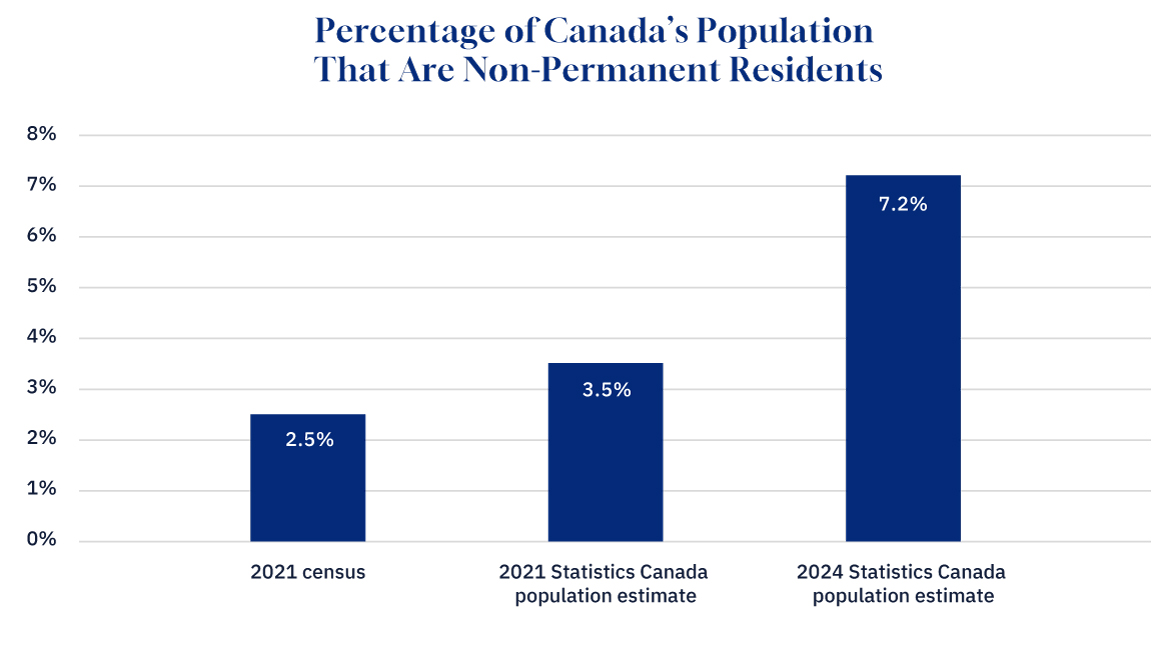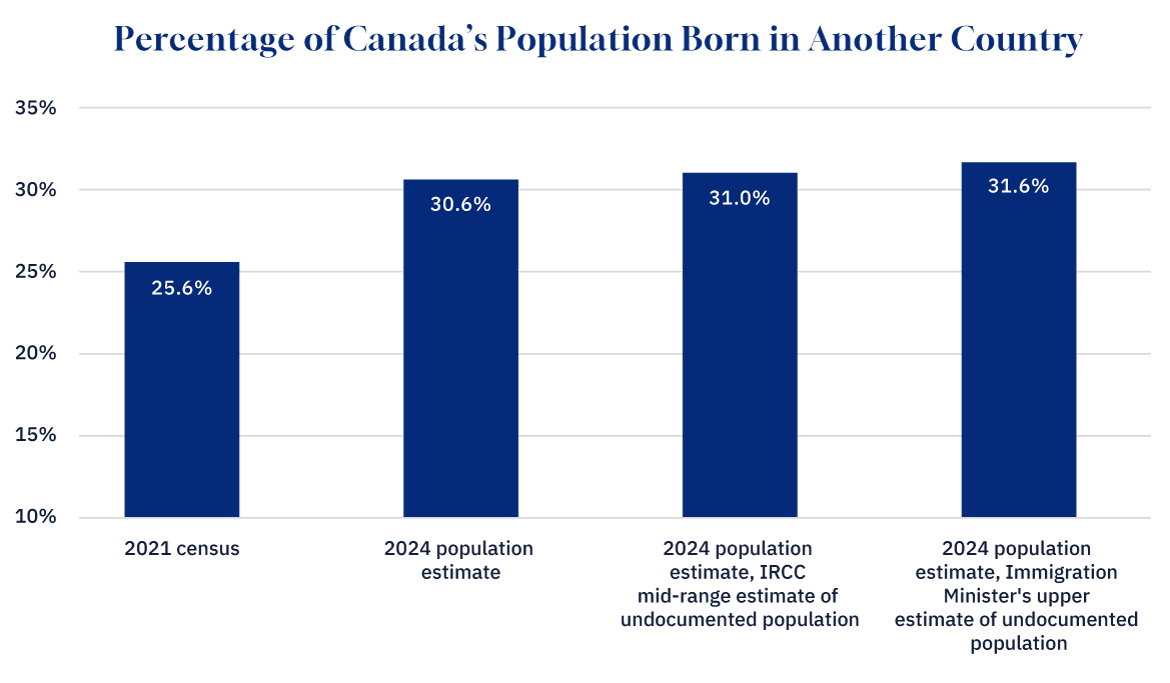DeepDives is a bi-weekly essay series exploring key issues related to the economy. The goal of the series is to provide Hub readers with original analysis of the economic trends and ideas that are shaping this high-stakes moment for Canadian productivity, prosperity, and economic well-being. The series features the writing of leading academics, area experts, and policy practitioners. The DeepDives series is made possible thanks to the ongoing support of Centre for Civic Engagement.
According to the most recent 2021 census, 23 percent of Canada’s population—or 8.3 million people—are reported to be either landed immigrants or permanent residents. This was up from 21.9 percent in the previous 2016 census.
These figures were widely circulated in the media as they represented a rather major demographic development: nearly one-quarter of Canadians are estimated to be immigrants—and that number was rapidly growing as rates increased. As highlighted by Statistics Canada, this was the highest percentage across the G7, and, in fact, the highest in Canada since Confederation, topping the previous record of 22.3 percent in 1921.
I however believe the number of Canadians born abroad could actually be approaching ten percentage points higher, once you fully account for non-permanent residents, overlooked residents, and undocumented residents to Canada.
NPRs
A big reason why is the growing number of non-permanent residents (NPRs). The 2021 Census estimated that an additional 2.5 percent of Canada’s population (924,850) were NPRs such as temporary workers, international students, and asylum seekers.
By accounting for NPRs in our overall tally, it brings us to 25.5 percent of Canada’s population reporting a birthplace outside of the country.
Of course, the distribution of this population not born in Canada (both landed immigrants and NPRs) is highly uneven across Canada, as newcomers have long been drawn to the country’s largest population centres. For example, according to the 2021 census, over nine out of 10 recent immigrants settled in one of Canada’s 41 census metropolitan areas, particularly Canada’s most populated cities.
For example, roughly half of Toronto’s population (46.6 percent) were not born in Canada. In Vancouver, it is 41.8 percent. In contrast, across much of rural and small-town Canada, this percentage is in the single digits, if not negligible.
Moving further, what has happened since census day, 2021? The most up-to-date population estimate puts Canada’s total population, as of July 1st, 2024, at 41,288,599 persons. This is an unprecedented growth of over 3 million persons in merely three years. The most important factor, by far, underlying this growth has been the increase in NPRs. StatsCan’s latest estimate is that the total number of NPRs in Canada have more than doubled since 2021 surpassing the 3 million mark.
The consequences of this major growth in the number of international students and temporary workers permits have been thoroughly discussed elsewhere, so I merely mention here the dramatic growth that has continued through to mid-2024, now up to an unprecedented 7.2 percent of the Canadian total population. Historically the NPR population had hovered at around 1 to 2 percent of Canada’s total, but more recently, this has been dramatically altered.

Graphic credit: Janice Nelson.
Those unaccounted for
A lesser-known dynamic is that the Canadian census survey is largely unable to account for “difficult to reach” populations, meaning that it actually understates the number of newcomers to Canada. This is a fact that StatsCan carefully documents in its studies on census coverage errors. In reference to coverage error, Statcan is referring to people who are completely missed in conducting a census. This would include many of the homeless, for example, or people between addresses, but it could also include persons who are new to Canada, have language difficulties, or are in fact unclear as to whether they are mandated to complete their census form (think of NPRs).
To give a sense of the magnitude of this error, one merely has to compare StatsCan’s total population count on the census day in May 2021 with its separate population estimate in July 2021: 36,991,981 compared to 38,239,864.
Is this 1.2 million undercount (or 3.1 percent of Canada’s total population) a big deal? Well, the devil is in the details.
Past research by StatsCan has demonstrated how the percentage of recent immigrants (landed over the previous five years) missed in the census has frequently surpassed 15 percent of recent immigrants, whereas for NPRs it has regularly surpassed the 40 percent mark of the total NPR population actually residing in Canada. This is hardly surprising given the linguistic difficulties of many newcomers, as well as a lack of clarity among NPRs as to who should be responding to the census. Again, compare this with the overall undercount for the population, which has hovered between 2 to 3 percent over recent censuses.
With this in mind, the number of immigrants, and in particular the number of NPRs, are in reality higher than reported in the 2021 census. Suggestive of this was StatsCan’s estimate (independent of the census) for July 1, 2021 of 1.3 million NPRs. This was about 40 percent higher than its census day count only six weeks earlier. If in fact the census count was adjusted for this higher figure, the census would have reported that roughly 3.5 percent of Canada’s population are NPRs rather than 2.5 percent.
Landed immigrants
The immigrant population has also grown, with 1,426,414 new immigrants since 2021. While StatsCan does not estimate the size of the population not born in Canada on a year-to-year basis (i.e. all landed immigrants and permanent residents currently living in Canada), it is possible to provide a reasonable estimate with StatsCan’s data. Assuming that some immigrants to Canada ultimately end up leaving, either returning to their origin country or elsewhere, and recognizing the small proportion of immigrants living in Canada dying each year, I have estimated that the total immigrant population living in Canada to be about 9.6 million in 2024, up by about a million since 2021.
This estimate is based on some rather conservative assumptions on its size and likely growth over this period, and might best be thought of as a lower limit estimate.
With this, I estimated that the immigrant population (i.e. all persons who were once landed immigrants and are now either Canadian citizens or permanent residents) has maintained its share of the overall population over the 2021-2024 period. This has occurred despite the phenomenal growth in NPRs. If we add StatsCan’s estimate of 3 million NPRs to the total immigrant population of 9.6 million, this leaves a total of 12.6 million in 2024—or 30.5 percent of Canada’s population born in another country. This clearly leaves a different impression than the roughly one in four as highlighted only two years ago.
Undocumented
There is clear evidence to suggest an even higher proportion. Yet in so doing, I introduce a high level of uncertainty. Here we can consider a small segment of Canada’s population that is completely absent in official statistics. Put simply, there is also the “undocumented population,” i.e. persons who have no authorization to reside and/or work in Canada, but do so anyway. StatsCan does not currently estimate this population, nor does any other government agency or department. In the U.S., rough estimates place the “non-documented” at roughly 11 million (or 3.3 percent of their population), whereas in Canada, researchers have historically suggested that it was very small, perhaps in the 50,000-100,000 range. More recently, estimates that have been circulated by the federal government appear to suggest that this segment of the population has grown quite noticeably.
On this issue, in discussing the policy option of granting landed immigrant status to some undocumented migrants, Immigration Minister Marc Miller stated back in December 2023 that the number of undocumented people in Canada likely ranged from 300,000 to 600,000, which not only suggests considerable growth but also a high level of uncertainty. Similarly, the Immigration, Refugee, and Citizenship Canada (IRCC) website provides an equally wide range, from the strangely low figure of only 20,000 up to 500,000. This is concerning as it suggests that a growing segment of Canada’s population is somehow attempting to live under the radar. Using IRCC’s mid-range estimate of 260,000 undocumented persons, the percentage of Canada’s population born abroad subsequently rises, albeit only slightly to 31 percent. Using the minister’s upper limit estimate, the percentage born in a country rises a bit further, up to 31.6 percent.

Graphic credit: Janice Nelson.
The difficult reality is that the actual number could be even higher than 600,000, yet Canada just does not have good information on this. If our share of the undocumented population matched the U.S. at 3.3 percent, Canada would have an undocumented population of roughly 1.36 million. While nobody is suggesting the number is that high, there is reason to believe that this segment of our population is growing—and could do so quite dramatically over the next couple of years.
Breaking with history
In reviewing these figures, one might reasonably be left with the impression that our immigration system is getting somewhat out of control. In a matter of only a few years, Canada has shifted from having roughly one-quarter of its population born abroad to a situation whereby we have clearly over three in 10.
Yet the real problem here is that much of the growth has been in the NPR category, which is a dramatic departure from our history of predominantly admitting landed immigrants. Historically, Canada made a commitment to newcomers that upon reaching Canadian soil they would eventually be granted the rights of full citizenship. It was a promise which has led to prosperity for our country. But this is obviously no longer the case, as a sizable number of persons currently living in Canada will never be given more than the “opportunity” to work or study here on a temporary basis. While these migrants were never guaranteed that their efforts would lead to citizenship, many have been left with the false impression that a study permit followed by a work permit was a near guarantee of gaining landed immigrant status.
According to announcements recently made by the federal government, we are set to see the percentage of NPRs decline over the next couple of years. Earlier this year Minister Miller announced that Ottawa is now committed to reducing the number of NPRs in Canada to 5 percent of the population by 2027.
However, the difficulty of this task is that a reduction in the number of NPRs may have consequences for the size of the undocumented population.
Research has suggested that the majority of the undocumented population currently living in Canada likely originally obtained temporary status as either temporary workers and/or international students and then lost their status as their permits expired. As Canada is currently engaged in tightening up its requirements for work and study permits, with many permits set to expire over the shorter term, one might correctly anticipate that the number of undocumented will continue to grow into the future. While the share of NPRs might be set to decline over the next couple of years, we might anticipate a corresponding growth in the undocumented population.
This is not a pretty picture for a country that has long prided itself on having one of the world’s most successful immigration systems, whereby newcomers were typically granted as landed immigrants the right to stay in Canada permanently. The Trudeau government should have been thinking not only about increasing immigration, foreign students, and temporary workers, but how many would be “too many.” They should have realized that it is far easier to increase immigration than to reduce it. They took the easy route and increased immigration thinking only of the benefits.
As a result of this apparent mismanagement of our immigration system, a growing proportion of people living in Canada only have the right to live here temporarily. Meanwhile, a growing proportion are in an exceptionally vulnerable position of being undocumented.
While over 30 percent of those in Canada are now born abroad, the uncontrolled nature of the growth has led to all sorts of issues relating to accommodation and the integration of this growth. This is not a pretty picture. It leaves many in a rather precarious situation and does not reflect well on Canada.










